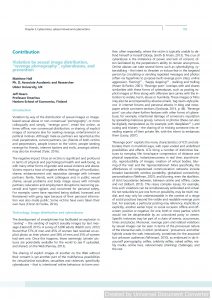Cybercrimes
Violation by Sexual Image Distribution, “Revenge Pornography”, Cyberabuses, and Prevention
 Full Article Title: Violation by Sexual Image Distribution, “Revenge Pornography”, Cyberabuses, and Prevention
Full Article Title: Violation by Sexual Image Distribution, “Revenge Pornography”, Cyberabuses, and Prevention
Open Access: Yes
Abstract
Chapter of Interest: Violation by Sexual Image Distribution, “Revenge Pornography”, Cyberabuses, and Prevention
Introduction Violation by way of the distribution of sexual images or image-based sexual abuse or non-consensual “pornography”, or more colloquially and simply, “revenge porn”, entail the online, at times offline, non-consensual distribution, or sharing, of explicit images of someone else for seeking revenge, entertainment or political motives. Although male ex-partners are reported as the main perpetrators, current partners, (ex-)friends of both victims and perpetrators, people known to the victim, people seeking revenge for friends, internet hackers and trolls, amongst others, may also be involved (Tyler, 2016). The negative impact it has on victims is significant and profound in terms of physical and psychological health and well-being, as with many other forms of gender and sexual violence and abuse. Victims report a host of negative effects: feelings of humiliation, shame, embarrassment and reputation damage with intimate partners, family, friends, work colleagues and, in public; sexual shame, sexual problems and body image issues with intimate partners; education and employment disruptions; becoming paranoid and hyper-vigilant, and concerned for personal safety. For example, some have reported being stalked, harassed and threatened with gang rape because of their personal information was also made public. Some victims have even taken their own lives (Citron & Franks, 2014).
Citation
Hall, M., & Hearn, J. (2018). Violation by sexual image distribution, “revenge pornography”, cyberabuses, and prevention. In Madriaza, P., de Palacio, A . Ponsot, A-S., Lemaire, P-A., Autixier, C., & Maury, S. (eds.), 6th International Report on Crime Prevention and Community Safety: Preventing Cybercrime (pp. 103-105). https://www.diva-portal.org/smash/record.jsf?pid=diva2%3A1278905&dswid=8776

